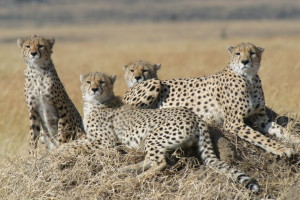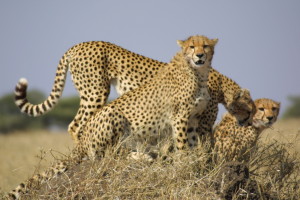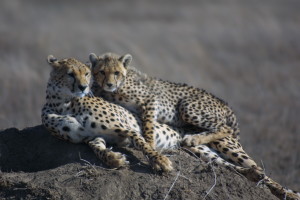- Scientists confirm 91% loss of historic range for iconic cat
- Estimates indicate just 7,100 cheetahs remain in wild
- Authors call for up-listing to ‘Endangered’ status on IUCN Red List
Press Release – The world’s fastest land animal, the cheetah (Acinonyx jubatus), is sprinting towards the edge of extinction and could soon be lost forever unless urgent, landscape-wide conservation action is taken, according to a study published today in the journal Proceedings of the National Academy of Sciences.
Led by ZSL (Zoological Society of London), Wildlife Conservation Society (WCS) and Panthera, the study estimates that just 7,100 cheetahs remain globally, inhabiting a mere nine per cent of the species’ historic range. Asiatic cheetah populations have been hit hardest, with fewer than 50 individuals remaining in one isolated pocket in Iran.
Due to the species’ dramatic and ongoing decline, the study’s authors are calling for the cheetah to be up-listed from ‘Vulnerable’ to ‘Endangered’ on the IUCN Red List of Threatened Species. In recognition of the threats it faces, wildlife in this category is given greater international conservation support, in efforts to stave off impending extinction.
Dr Sarah Durant, ZSL/WCS lead author and Project Leader for the Rangewide Conservation Program for Cheetah and African Wild Dog, said: “This study represents the most comprehensive analysis of cheetah status to date. Given the secretive nature of this elusive cat, it has been difficult to gather hard information on the species, leading to its plight being overlooked. Our findings show that the large space requirements for cheetah, coupled with the complex range of threats faced by the species in the wild, mean that it is likely to be much more vulnerable to extinction than was previously thought.
“We have worked with range state governments and the cheetah conservation community to put in place comprehensive frameworks for action to save the species, but funds and resources are needed to implement them. The recent decisions made at the CITES CoP17 meeting in Johannesburg represent a significant breakthrough, particularly in terms of stemming the illegal flow of live cats trafficked out of the Horn of Africa region. However, concerted action is needed to reverse ongoing declines in the face of accelerating land use changes across the continent.”
While renowned for its speed and spots, the degree of persecution cheetahs face both inside and outside of protected areas is largely unrecognised. Even within well-managed parks and reserves, cheetahs rarely escape the pervasive threats of human-wildlife conflict; prey loss due to overhunting by people; habitat loss; and the illegal trafficking of cheetah parts and trade as exotic pets.
- Four cheetah. Credit: ZSL
- Chablis and cubs. Credit: ZSL
- Angie and cub. Credit: ZSL
- Angie and cub. Credit: ZSL
- A pair of Cheetahs pictured during one of the Institute of Zoology’s field conservation projects, Tanzania Carnivore Program.
- A Cheetah in the Serangeti in Tanzania, taken on conservation Programme’s ongoing field work with Cheetahs.
To make matters worse, as one of the world’s most wide-ranging carnivores, 77 per cent of remaining cheetah habitat falls outside of protected areas. Unrestricted by boundaries, the species’ wide-ranging movements makes enforcement of protection particularly challenging and greatly amplifies its vulnerability to human impacts. In Zimbabwe, for example, these pressures have seen the cheetah population plummet from 1,200 to a maximum of 170 animals in just 16 years – representing an astonishing loss of 85 per cent of the country’s cheetahs.
Scientists are now calling for an urgent revolution in how we approach cheetah conservation, focused towards landscape-level efforts that transcend national borders and are coordinated by existing regional conservation strategies for the species. A holistic conservation approach, which incentivises protection of cheetahs by local communities and trans-national governments, alongside sustainable human-wildlife coexistence, is paramount to the survival of the species.
Panthera’s Cheetah Programme Director, Dr Kim Young-Overton, shared: “We’ve just hit the reset button in our understanding of how close cheetahs are to extinction. The take-away from this pinnacle study is that securing protected areas alone is not enough. We must think bigger, conserving across the mosaic of protected and unprotected landscapes that these far-reaching cats inhabit, If we are to avert the otherwise certain loss of the cheetah forever.”
The methodology used for this study will also be relevant to other species, such as African wild dogs, which also require large areas of land to prosper and are therefore similarly vulnerable to increasing threats outside designated protected areas.
Learn more here about the Rangewide Conservation Programme for Cheetah and African Wild Dogs.











